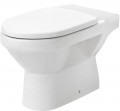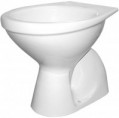Drain (to the sewer)
The design of the outlet pipe of the toilet bowl. It determines, in particular, the features of its installation. To date, there are such options:
—
Horizontal. In such toilets, the outlet pipe is located at the back of the bowl and is oriented horizontally backwards. This is one of the most common types in Europe and the post-Soviet space - it is due to the fact that sewer pipes in these countries are drawn along the floors, and the pipe in the bathroom is usually located under the wall, behind the toilet.
—
Oblique. In fact - a kind of horizontal release (see above), in which the outlet pipe is not strictly horizontal, but at an angle (usually 30° or 45°). It will be useful in the case that the sewer pipe is low, near the floor.
—
Vertical. As the name suggests, in these toilets the output is directed vertically down. They are mainly used in the United States and other American countries, where in the construction of communications, e.g. sewerage, conducted under the floor (ceiling) without taking into account the partitions - as a result, the toilet can be placed directly above the pipe. This layout is also found in the post-Soviet space, in particular in office and production premises, as well as in residential buildings on individual projects.
—
Universal. The universal release design allows it
...to be connected to one of the three above options, depending on the specific need. Most often, the output of such toilets is hidden inside, and its own nozzle is absent; for connection selected separate pipe of the desired shape, it can go vertically, horizontally or at an angle.
It should be noted that it is theoretically possible to install a toilet with horizontal release in the bathroom under the vertical, and vice versa - but in practice, this is very difficult and actually requires the reconstruction of the toilet. And therefore, before choosing a toilet, you must clarify the design of sewer pipes in your bathroom and the most suitable type of outlet.Bowl shape
The overall shape of the toilet bowl.
The choice of this parameter largely depends on the aesthetic preferences of the user and the overall design of the bathroom; however, the shape of the bowl is quite practical. So, in our time, the most common is
semicircular models, where the rear edge of the bowl is made straight, and the rest - rounded (oval, egg-like, etc.). This shape not only looks good - it is convenient to sit on, and the absence of angles (at least in front of the bowl) facilitates cleaning and reduces the risk of hitting the toilet with your foot. In addition, material on such a bowl requires less than a rectangular product of similar dimensions - as a result, semi-circular toilet bowls are relatively inexpensive and light.
The rectangular shape, in turn, gives a larger support area, which is important for users of large physique. However, toilet bowls
classical rectangular shape are rare (due to the high cost of production, as well as for some other reasons). Much more common are variations on this topic - the bowls
, with bevelled (rounded) corners, as well as
, with the front end shaped arc.
Weight
The total weight of the product; for compact-toilet (cf. «Type»), as a rule, is specified for standard equipment - together with «native» tank (empty).
When choosing floor models on this indicator you can not pay much attention, but for a hanging toilet bowl (see. «Installation») weight is quite principial: because the installation (or other attachment) should normally withstand both the design and the user sitting on it.
Bowl height
The height of the toilet bowl, namely the upper edge of the bowl.
In floor models (cf. «Installation») this size is considered from the base, in suspended - from the bottom edge. It should be borne in mind that hanging articles are usually set at a height of at least 5 - 10 cm above the floor, so the actual height of the bowl will be greater by the appropriate amount. Flooring models are usually placed at the floor level, and the actual height of the bowl in them corresponds to the stated (theoretically it is possible to adjust this height by installing the toilet at an elevation or recess, but in practice it is easier to choose the model of the desired height).
The lowest height values -
up to 30 cm inclusive - can be found exclusively in hanging toilets (this is not inconvenient given the features of installation). The same type of installation applies to most models on
31 - 34 cm and
35 - 37 cm, although these categories already include floor products. However, among the latter, the most popular height -
38 - 40 cm, is also very common outdoor toilet bowls height
more than 40 cm (in suspended models the height is higher than 38 cm and rare).
Regarding the choice of this parameter, it is worth considering the use of the toilet. Thus, for public use, the best option is considere
...d to be the actual height of the bowl of 40 - 44 cm; this height is clearly prescribed in some sanitary standards, it is convenient for most adults and is quite acceptable for children (except for the smallest, who already require the help of an adult when using the toilet). But for personal use, the toilet should be selected more carefully, and here may be suitable values. The general rule is that, ideally, the legs of a seated person should be bent at a right angle and freely stand on the floor without hanging or straining themselves beyond measure. However, people in the family may differ markedly in stature and needs. In general, therefore, it is recommended to take into account the growth of the highest family member and, in the case of a person with special needs, those needs first.Dimensions (HxWxD)
General dimensions of the toilet bowl in height, width and depth (by depth is meant the distance from the front edge to the rear edge).
These indicators allow you to determine how much space is required to install the product, and also affect some practical points. In this case, width and depth are of key importance. Specific figures and nuances for these dimensions are as follows:
- Width:
up to 35 cm in the narrowest models,
40 cm or more in the widest, intermediate options -
36 - 37 cm and
38 - 39 cm. A large width is desirable if people of large build will use the toilet. However, it should be borne in mind that this dimensions is indicated by the widest part of the structure, and this is not necessarily a bowl - we can talk about a tank.
- Depth:
up to 50 cm - is considered small, in the largest products -
more than 65 cm ; intermediate options include
51 - 55 cm,
56 - 60 cm and
61 - 65 cm. Here the choice depends on the height and physique of the user: tall people and people with long legs will be most comfortable with toilets with great depth.
Height is worth mentioning. In models without a tank, it corresponds to the height of the bowl
..., see more about this indicator above. In compact toilets (see "Type"), the height with the tank is usually indicated, it depends on how much vertical space is required for installation. Here, an indicator of 75 cm or less is considered small, 76 - 80 cm is average, 81 - 85 cm is above average, and for the highest products, more than 85 cm of free space above the floor will be required.Country of origin
The country of origin of the brand under which the toilet is marketed. Nowadays, on sale you can mainly find products from such countries (in alphabetical order):
Belgium,
Germany,
India,
Spain,
Italy,
Poland,
Turkey,
France,
Czech Republic,
Switzerland,
Sweden,
Japan.
There are many stereotypes related to how the origin of goods from a particular country affects their quality. However, in general, these stereotypes are unfounded. Firstly, this paragraph does not indicate the actual place of manufacture of the toilet bowl, but the "homeland" of the trademark (or the location of the manufacturer's headquarters); production facilities may be located in another country. Secondly, the actual quality of the product depends not so much on geography, but on the organization of processes within a particular company. So when choosing, it is best to focus not so much on the "nationality" of the toilet, but on the overall reputation of a particular brand. And paying attention to the country of origin makes sense if you fundamentally want (or do not want) to support a manufacturer from a
...certain state.
